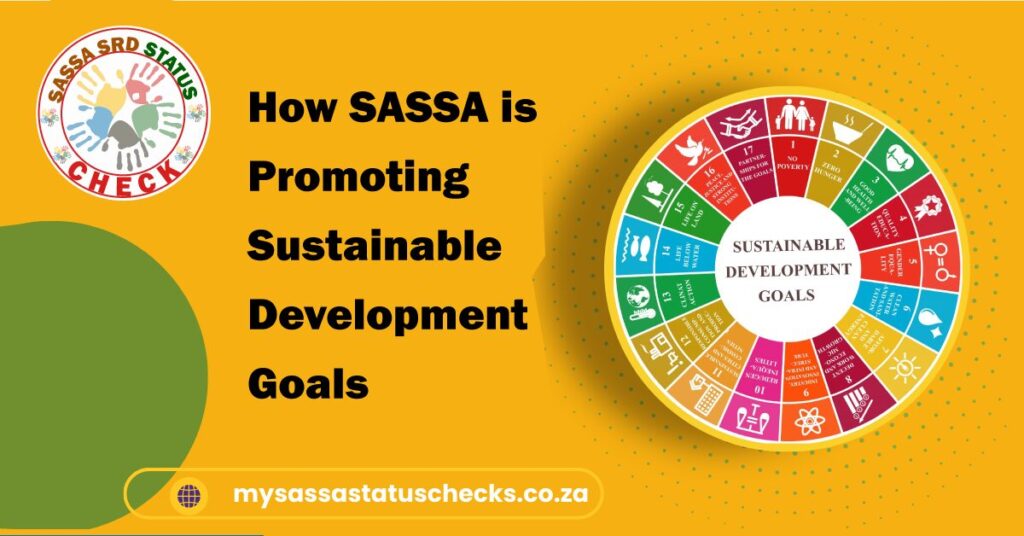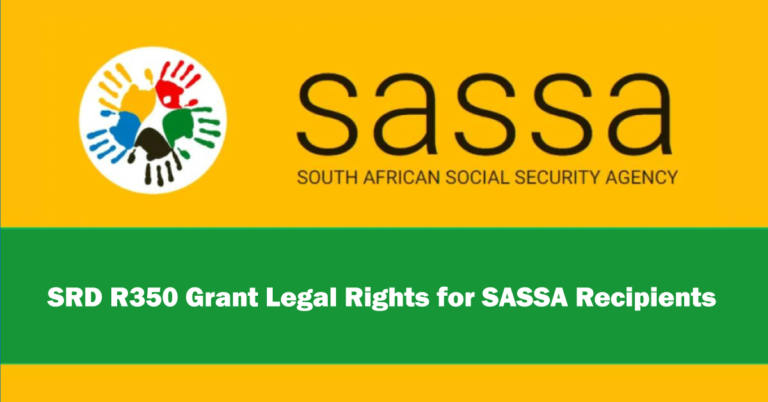How SASSA is Promoting Sustainable Development Goals
SASSA sustainable development goals
The South African Social Security Agency (SASSA) provides social grants for millions of people to fight against poverty. Moreover, they have access to their necessities. SASSA provides financial support and contributes to the Sustainable Development Goals (SDGs). The United Nations set these goals to tackle global challenges and create a more sustainable future in the 2030s. Let’s understand how SASSA helps to solve the world’s challenges, like poverty, health issues, climate change, and so on.

To understand the 17 Sustainable Development Goals:
In 2015, 17 goals of Sustainable development were launched by the United States to protect the planet, growing peacefulness and prosperity among the people and in the future. These are designed to address the following challenges:
1. To end Poverty (SDG 1):
It directly addresses poverty by providing a lifeline for vulnerable individuals and households, ensuring they have access to basic needs.
2. Zero Hunger (SDG 2):
Many people suffer from malnutrition in many countries because of climate change and deforestation. SDGs support and educate farmers to use the latest technology to promote agriculture to end hunger and provide essential nutrition to people. Almost half of the rate of malnourished people has decreased due to this step of SDGs.
3. Good Health and Well-being (SDG 3):
Before 2017 many people died due to several diseases. 80% Health rate has increased as SDGs launch different vaccines for different diseases.
4. Quality Education (SDG 4):
Many children skip their education due to poverty. At the same time, education is important for sustainable development. So, SASSA provides loans or bursaries to the students to get quality education and learn skills.
5. Gender Equality (SDG 5):
SDGs eliminate all the discrimination against women and girls. It is proved that empowering them will help to increase economic growth and development.
6. Clean Water and Sanitation (SDG 6):
40% of people face water scarcity globally. The goal is to ensure that all the people in 2030 get clean and sterilized water. For Around 40% of people worldwide face water scarcity today. The goal is to provide clean and safe water to everyone by 2030. Plans are made to invest in proper sanitation systems and improve hygiene. These efforts support global health and environmental sustainability goals.
7. Affordable and Clean Energy (SDG 7):
As the population increases the demand for electricity increases. SDG 7 is responsible for investing in thermal energy, solar and wind which ensures that cheap electricity and fuel are produced for all the countries.
8. Decent Work and Economic Growth (SDG 8):
Due to poverty, many people lack access to proper education and training, which often leads to unemployment. The Sustainable Development Goals (SDGs) aim to address this by promoting equal access to quality education and skill development. These efforts help boost productivity and support innovation. The main goal is to create decent job opportunities so people can live without financial struggle.
9. Industry, Innovation, and Infrastructure (SDG 9):
Investment in innovation is essential for sustainable growth and development. Many countries still lack internet connection, electricity and proper water supply. The goal is to build new industries and encourage innovation to fight against economic and environmental issues to provide jobs for people and promote enough energy. Bridging this gap is to ensure that all people get a proper education and have access to global knowledge irrespective of gender.
10. Reduced Inequalities (SDG 10):
Income inequality exists everywhere in the world , with the rich growing richer and the poor falling further behind. This issue needs a global response. The goal is to ensure equal opportunities for both men and women in social, political, and economic areas. Efforts also focus on reducing inequality between countries by improving financial markets and directing investments where they are most needed.
11. Sustainable Cities and Communities (SGD 11):
More facilities are offered in Cities than the rural areas, including better jobs, lower living costs, and business options. As a result, many people move to cities for a better life, causing urban populations to grow quickly. This leads to the rise in population in many cities. To make cities more sustainable, plans focus on improving city management and economic systems. These include more career opportunities, affordable housing, and safer transport.
12. Responsible Consumption and Production (SGD 12):
For sustaining development, we must change how we consume and produce goods and services. The goal is to ensure that all the toxic waste produced by the industries should be disposed of. They also encourage factories to recycle products as it involves a crucial step in the sustainable growth of countries.
13. Climate Action (SDG 13):
Every country faces the experience of climate change. Global warming has an irreversible effect on our climate system if we do not take proper precautions. To avoid these issues, SASSA invests in forestation and uses the latest technology and natural resources to stop increasing the temperature after a certain limit.
14. Life Below Water (SDG 14):
Around three billion individuals depend on marine animals for their living. The industry’s waste and plastic are the major cause of marine pollution. To overcome this problem SDG’s objective is to protect marine ecosystems from pollution and acidification by reducing plastic waste and litter.
15. Life on Land (SDG 15):
Human life gets 80% of its nutrients from plants and agriculture is the most important economic resource. The goals are to plant forests, protect the land from any natural disaster and save the environment from climate change and people get enough food from the plants. Forests are 80% territory for many species.
16. Peace, Justice, and Strong Institutions (SDG 16):
Some areas of the world have peace and prosperity, while the other half experience war, injustice, human trafficking and so on. The aim is to reduce violence and make laws on a higher level to avoid injustice as sustainable development can’t be sustained without abiding by proper rules and regulations.
17. Partnerships for the Goals:
The goal is to increase cooperation globally to promote international trade and help to raise exports for developing countries.
Conclusion:
SASSA supports the 17 Sustainable Development Goals (SDGs) in South Africa. Through social grants and teamwork, SASSA helps reduce hunger, poverty, and inequality. It also supports education, youth employment, and access to justice. By promoting human rights and fair laws, SASSA works to reduce crime. With these goals, SASSA remains committed to progress, innovation, and building a better future for all South Africans.
Frequently Asked Questions (FAQS)
Q1. What are the goals of SASSA?
Ans: To provide inclusive and accessible social security services that protect and empower vulnerable people living in South Africa, using modern, customer-centric, and innovative approaches.
Q2. What is the purpose of Sustainable Development Goals?
Ans: The Sustainable Development Goals (SDGs) aim to transform our world. They are a call to action to end poverty and inequality, protect the planet, and ensure that all people enjoy health, justice, and prosperity.
Q3. What are the five pillars of the SDGs?
Ans: the five pillars of the 2030 Agenda: People, Planet, Prosperity, Peace, and Partnerships.
Q4. who benefits from SASSA?
Ans: Social Relief of Distress is paid to South African citizens or permanent residents who have insufficient means.




